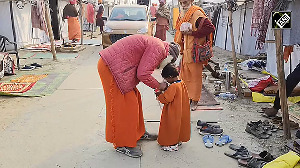Even as World Trade Organization director general Pascal Lamy has claimed that a successful Doha Round will lead to rich nations undertaking steeper tariff cuts than developing and poor nations, an analysis of the proposals shows the opposite may be true.
Lamy, who was recently in New Delhi to canvass for the deal, said a successful Doha Round would lead to 60 per cent reduction in import tariffs of rich economies, while others would have to cut their tariffs by only 35 per cent.
In effect, Lamy was pushing the point that the principles of less-than-full-reciprocity and special and differential treatment which allow developing and poor nations to undertake lesser tariff cuts are being followed.
Indian experts disagree. "This is far from truth. Developing nations will have to undertake far higher cuts than rich countries. The current proposals turn the principles of LTFR and S&DT on their head," says Nagesh Kumar, director general, Research and Information System for Developing Countries.
An analysis of the formula-based tariff cuts on non-agricultural market access seems to buttress Kumar's point. For example, if a Swiss coefficient (a component in the tariff cut formula) of eight is taken for the European Union, the United States and Japan, they will undertake an average tariff cut of nearly 28 per cent.
However, if a coefficient of 22, as proposed in the Doha draft texts is taken into account for developing nations, India, Brazil and Indonesia will have to cut tariffs by an average of over 61.55 per cent. The current WTO draft text on Nama proposes three sets of swiss coefficients for developing countries - 20, 22 and 25.
In farm goods, rich countries would undertake a higher average tariff cut of 54 per cent, as against 36 per cent for developing countries.
"But there is a catch. The cut proposed for developing countries is more than what was there in the Uruguay Round, which preceded Doha. Moreover, the high farm subsidies in rich nations will suppress domestic prices of farm goods. As a result, emerging economies and poor nations will not have any market access in developed countries," said Bhaskar Goswami, agriculture expert with the Forum for Biotechnology & Food Security.
According to a recent WTO report, merchandise global exports in 2007 stood at $13.6 trillion, of which the share of developing countries was $5 trillion. Least developed countries contributed $120 billion.
Lamy said the Doha deal would halve the import tariffs worth $300 billion. Of this, two-third reductions will be carried out by rich countries, while the rest will be by emerging economies like India as well as low income and least developed countries.
"It is a very simple number, but not an economically significant number. Nearly $150 billion savings in goods for a consumer is a plus for the (global) economy," Lamy told Business Standard in a recent interview. He added the United States and the European Union would forgo duties worth nearly $1.5 billion on Indian exports if the Doha deal came through.
Kumar says Lamy's logic on reduction of import duties may not be good for a country. "For many small economies like the Maldives, Customs duties are the major source of revenue as income levels are low. This would have an impact on spending on public projects. This is also true for India as Customs collections are a large share of the total revenue".
Data for 2007-08 show that Customs collections comprised more than 17 per cent of the Rs 594,600 crore (Rs 5,946 billion) revenue.






 © 2025
© 2025